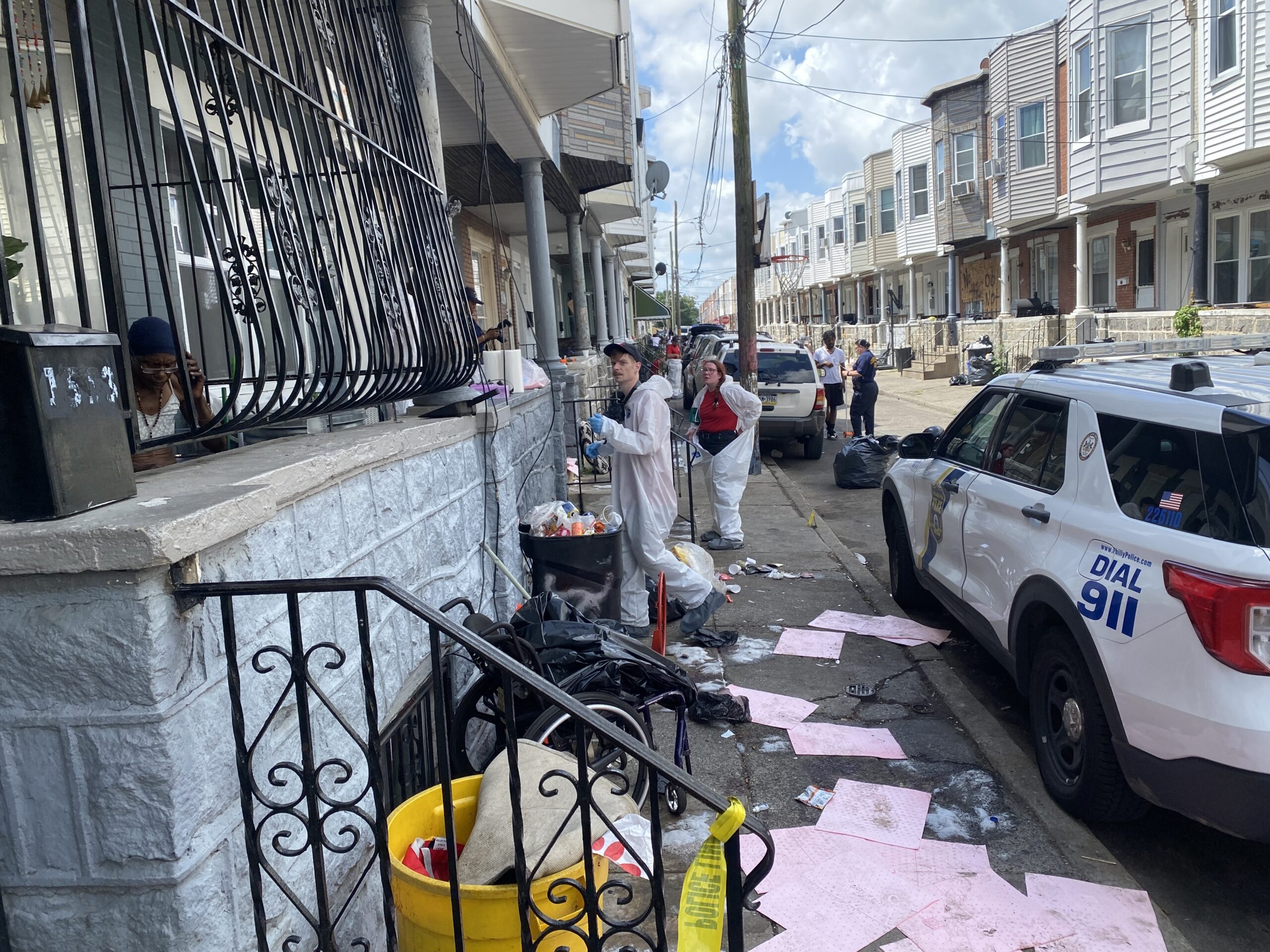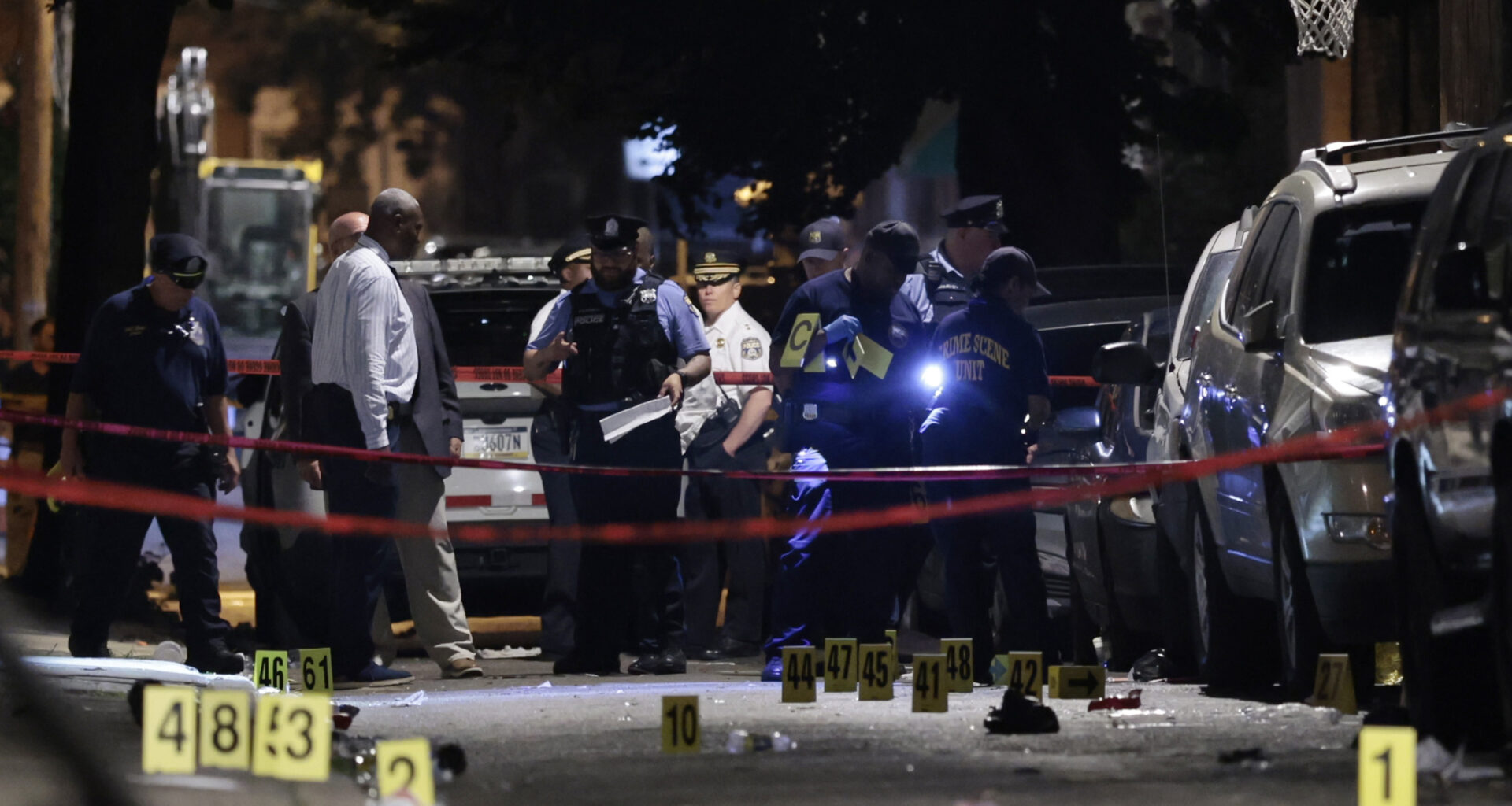Just days after the Fourth of July, 13 people were shot during a mass shooting in South Philadelphia. As the camera crews left and police cleared the narrow one-way street in Grays Ferry, biohazard service employees hired by the city began scrubbing away the debris, blood, and other detritus.
The Trace’s Mensah M. Dean captured images of chalk circles on the sidewalk, a car riddled with bullets, and bloodstained steps. Community members are often tasked with cleaning up crime scenes after shootings like that, but in this instance, they had help. They will still have to make some repairs, and there will be lasting emotional scars, but because the city brought in a cleaning crew, many residents could begin their healing process without enduring additional trauma from getting blood on their hands.
I know firsthand that cleaning a crime scene in or near your home can take a heavy emotional toll, especially when there is a connection to the victim. I have family members and friends who were left to do this gruesome labor themselves. In my first month at The Trace, I wrote about my mother’s traumatizing experience cleaning up a crime scene. Through my reporting, I realized that it was a growing problem in Philadelphia: As shootings increased, more residents were left responsible for cleaning up the blood.
In November 2023, Philadelphia launched a pilot program to shift responsibility for cleaning up after shootings to city-contracted professionals — the type of service I wish had been available for my family and friends.
I recently spoke with Adara Combs, the city’s director of the Office of the Victim Advocate, to find out how the pilot program is working, what’s changed since the launch, and what’s next. Here’s what I learned.
More than a year into the pilot program, Combs said, crews have cleaned up 141 crime scenes. “The 141 crime scenes may seem like a small number in comparison to how many shootings there have been citywide,” she said, “but for the people who no longer have to clean crime scenes on their blocks and in front of their stores, it’s making an impact.”
The cleanup services were initially limited to public spaces, but now, the city has started making some exceptions, cleaning blood off gates or porches when they’re accessible.
After testing its cleanup services in the 25th and 26th police districts, which include Kensington and Port Richmond, the city has expanded the program to West, Southwest, Central, and the Northwest police division, areas that include neighborhoods like Mills Creek, Cobbs Creek, Nicetown, Tioga, Strawberry Mansion, and Temple University. The program isn’t yet in South Philadelphia, but the city made an exception for Grays Ferry, because of the severity of the mass shooting there. Combs said she expects the program to expand citywide by December 2025.

Philadelphia’s crime scene cleanup program isn’t yet active in South Philadelphia, but officials deployed city-contracted cleanup crews in the aftermath of the Grays Ferry mass shooting because of its severity. / Mensah M. Dean for The Trace
Combs discussed the program’s rollout, its roadbumps, and the city’s revisions. This conversation has been condensed and lightly edited for clarity.
Afea Tucker: Has the program been working the way the city originally envisioned?
Adara Combs:
It has. Once we received the go-ahead from Mayor Parker, we worked with our Office of Public Safety, the Police Department, and our vendor to roll it out. We started with the 25th and 26th districts and expanded gradually — intentionally — district by district. That allowed us to train officers thoroughly and make necessary tweaks as we went. Overall, the program is operating as planned, if not better, because of those refinements.
AT: What kind of changes have you made based on feedback?
AC: We’ve added a few things. For example, initially, the program only covered public spaces. But we’ve expanded to clean blood off cars or front steps if it’s connected to the crime scene, assuming there’s no gate or barrier.
We now include the removal of chalk outlines and police tape. One resident pointed out that even after the blood was cleaned, their children were still walking past visible reminders like circled shell casings.
We also partnered with CLIP — the Community Life Improvement Program — to assess quality-of-life issues in affected areas. Within 48 hours of a crime scene cleanup, CLIP crews visit to assess the cleanup and other potential hazards. They’ll send us back a referral form and upon approval will go back into the community and clean up litter, broken glass, needles, and other issues that affect how safe and cared-for a community feels.
AT: What’s the protocol when a crime occurs? Can residents request a cleanup?
AC: No, and that’s by design. Officers at the scene make the request through police radio as soon as the crime scene is cleared. The vendor then responds within 90 minutes — on average, they’ve been arriving in 48. We didn’t want to put the onus on community members.
AT: What has community feedback looked like?
AC: People are relieved not to have to clean up these scenes themselves. One moment that sticks with me happened after the July 4th mass shooting last year — a woman came out of her house with a bucket and cleaning supplies, getting ready to clean up blood in front of her home. We were able to intervene and send out our vendor. People shouldn’t have to do that.
AT: Have there been any obstacles to the rollout?
AC: The biggest challenge has been moving quickly enough to get citywide. Each district requires in-person officer training. It takes time, but it ensures quality.
AT: Are you seeing repeat service in certain areas or blocks?
AC: We haven’t noticed anything outside of expected patterns.
AT: How flexible is the cleanup response?
AC: Very. The number of technicians depends on the size of the scene. For example, a mass shooting like last year’s July 4 incident may require a larger team and specialized materials, especially if it happens inside a recreation center. The vendor handles that assessment during the initial call. There have also been instances when a crime-scene cleanup has been employed by our office in districts that are not in our service areas.
AT: What’s the cost of this program?
AC: It’s hard to estimate right now. We’re not yet citywide and haven’t gone through a full summer citywide, either. We’ll have a better idea after December.
AT: What are the next steps or goals beyond citywide expansion?
AC: First and foremost: expansion by year’s end. Beyond that, we want to think creatively about how to provide resources in the moment — maybe door hangers or cards with city service info for residents who’ve just experienced trauma. We’re also looking for ways to better support officers and vendors as they engage with people on the ground.
AT: Does the city stay in touch with victims or families after these incidents?
AC: Yes. The Office of the Victim Advocate sends letters within 24 hours of a homicide to offer condolences and provide a list of resources. We also work with the Office of Safe Neighborhoods, Community Relations Officers, and community-based groups to maintain engagement. Some people want to talk to someone in the city government. Others prefer community advocates. We try to meet people where they are and offer multiple ways to stay connected.

The Trace’s reporting in Philadelphia is a part of Every Voice, Every Vote, a collaborative project managed by The Lenfest Institute for Journalism. The William Penn Foundation provides lead support for Every Voice, Every Vote in 2024 and 2025 with additional funding from The Lenfest Institute for Journalism, Comcast NBC Universal, The John S. and James L. Knight Foundation, Henry L. Kimelman Family Foundation, Judy and Peter Leone, Arctos Foundation, Wyncote Foundation, 25th Century Foundation, Dolfinger-McMahon Foundation, and Philadelphia Health Partnership. To learn more about the project and view a full list of supporters, visit www.everyvoice-everyvote.org. Editorial content is created independently of the project’s donors.
